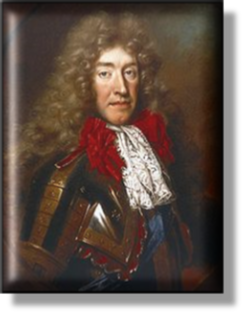 xxxxxAs Duke of York (the second son of Charles I) James
was forced into exile at the end of the English Civil War, but
returned to England when his brother was restored to the throne.
He served as lord high admiral, taking part in the Anglo-Dutch
Wars, and helping to improve the organisation and efficiency of
the navy. An avowed Roman Catholic since 1671, he became king of
Great Britain on the death of his brother, meeting only limited
opposition, in spite of his religious beliefs.
xxxxxAs Duke of York (the second son of Charles I) James
was forced into exile at the end of the English Civil War, but
returned to England when his brother was restored to the throne.
He served as lord high admiral, taking part in the Anglo-Dutch
Wars, and helping to improve the organisation and efficiency of
the navy. An avowed Roman Catholic since 1671, he became king of
Great Britain on the death of his brother, meeting only limited
opposition, in spite of his religious beliefs.
xxxxxAs we have
seen, during
the reign of Charles II, opposition to a Roman Catholic monarch
had been clearly demonstrated and acted upon. The uncovering of
the Popish Plot - allegedly designed to put James on the
throne - deeply alarmed the Protestant community, and was
followed by the proposed Exclusion Bill, specifically designed to
ban the Duke of York from the succession. When this failed, there
followed the Rye House Plot of 1683, an unsuccessful attempt to
kill both Charles II - a Roman Catholic at heart - and
his brother James, his rightful heir.
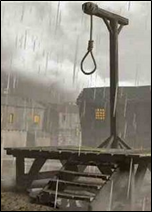 xxxxxIt was against this background that James II came to
the throne in February 1685. He had hardly had time to sit on it
before he was confronted by the Monmouth Rebellion. James Scott,
the Duke of Monmouth, an illegitimate son of Charles II, having
landed at Lyme Regis on the south coast, moved inland with a force
of some 4,000 men and, capturing Taunton in the June, was
proclaimed King of England. Fortunately for James II, his army
remained loyal to him as the rightful heir, and Monmouth's ragged
force was soundly beaten. Severe "justice" was then meted out to
the rebels by the infamous Judge Jeffreys via what came to be
known as the "Bloody Assizes".
Monmouth was beheaded - as was the Earl of Argyll who had led
an unsuccessful rising in Scotland - and over one thousand of
his supporters were either hanged or transported into slavery.
xxxxxIt was against this background that James II came to
the throne in February 1685. He had hardly had time to sit on it
before he was confronted by the Monmouth Rebellion. James Scott,
the Duke of Monmouth, an illegitimate son of Charles II, having
landed at Lyme Regis on the south coast, moved inland with a force
of some 4,000 men and, capturing Taunton in the June, was
proclaimed King of England. Fortunately for James II, his army
remained loyal to him as the rightful heir, and Monmouth's ragged
force was soundly beaten. Severe "justice" was then meted out to
the rebels by the infamous Judge Jeffreys via what came to be
known as the "Bloody Assizes".
Monmouth was beheaded - as was the Earl of Argyll who had led
an unsuccessful rising in Scotland - and over one thousand of
his supporters were either hanged or transported into slavery.
xxxxxThe
relatively easy defeat of the usurper Monmouth gave the king a
false sense of security, and he thus failed to appreciate the
strength of Protestant opinion in England. In fact, the heavy-handed
reprisals against Monmouth and his protestant supporters
infuriated the majority of his subjects. And their anger was
increased the more in November of that year when James dismissed
Parliament and began to use his revenue to raise a standing army.
Many Tories joined with the Whigs in opposition to the king.
Furthermore, having promised to defend the Church of England, in
1687 James issued his Declaration of Indulgence
which, by granting freedom of worship to all religions,
enabled him to appoint Catholics to high office. Catholics joined
his privy council, assumed command of the army and navy, and took
up top appointments in the Universities.
xxxxxSuch actions
were viewed with alarm by the Protestants, and matters came to a
head in May 1688 when, having reissued his Declaration of
Indulgence, James II ordered that it be read out in churches
throughout the land. This dictate proved highly unpopular, and the
Archbishop of Canterbury and six of his bishops petitioned the
king to withdraw the order. They were taken to court on a charge
of seditious libel, but were acquitted amid widespread rejoicing.
Meanwhile the birth of a son to the kin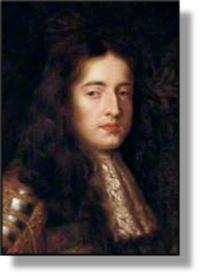 g
threatened the continuation of a Catholic monarchy, and added to
the need for urgent action. Secret plans were set in motion to
dethrone the king. Seven leading Englishmen invited the Dutch and
Protestant William of Orange (illustrated), husband of James II's daughter Mary, to invade
England and seize the crown. He landed at Brixham in Devon in
November and, meeting no opposition, arrived in London the following
month. In the meantime, James II, deserted by his army, was allowed
to escape to France, where he vowed to return to regain his throne.
As we shall see, he
did return in 1689 (W3),
but his cause was lost. The “Glorious Revolution”, achieved without
a shot being fired, was here to stay and was to prove a major step
towards constitutional monarchy.
g
threatened the continuation of a Catholic monarchy, and added to
the need for urgent action. Secret plans were set in motion to
dethrone the king. Seven leading Englishmen invited the Dutch and
Protestant William of Orange (illustrated), husband of James II's daughter Mary, to invade
England and seize the crown. He landed at Brixham in Devon in
November and, meeting no opposition, arrived in London the following
month. In the meantime, James II, deserted by his army, was allowed
to escape to France, where he vowed to return to regain his throne.
As we shall see, he
did return in 1689 (W3),
but his cause was lost. The “Glorious Revolution”, achieved without
a shot being fired, was here to stay and was to prove a major step
towards constitutional monarchy.
xxxxxIncidentally, when the birth of the royal prince was announced, a
rumour went the rounds that the baby was not James's and had been
smuggled into the Queen's bedroom in a warming pan! ...... The
invitation to William to "invade" England was delivered personally
by Admiral William Herbert. In order to keep this matter secret he
went dressed as a common seaman. ...... Before departing for the
continent, James II made a will, witnessed, among others, by the
diarist Samuel Pepys, then serving as first lord and secretary of
the Admiralty.



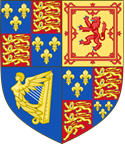






 The
The
 The
brilliant English scientist
The
brilliant English scientist 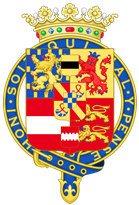 In
order to save the country from a return to Roman Catholicism,
seven eminent lords invite the Dutch William
In
order to save the country from a return to Roman Catholicism,
seven eminent lords invite the Dutch William xxxxx
xxxxx xxxxx
xxxxx g
threatened the continuation of a Catholic monarchy, and added to
the need for urgent action. Secret plans were set in motion to
dethrone the king. Seven leading Englishmen invited the Dutch and
Protestant William of Orange (
g
threatened the continuation of a Catholic monarchy, and added to
the need for urgent action. Secret plans were set in motion to
dethrone the king. Seven leading Englishmen invited the Dutch and
Protestant William of Orange (